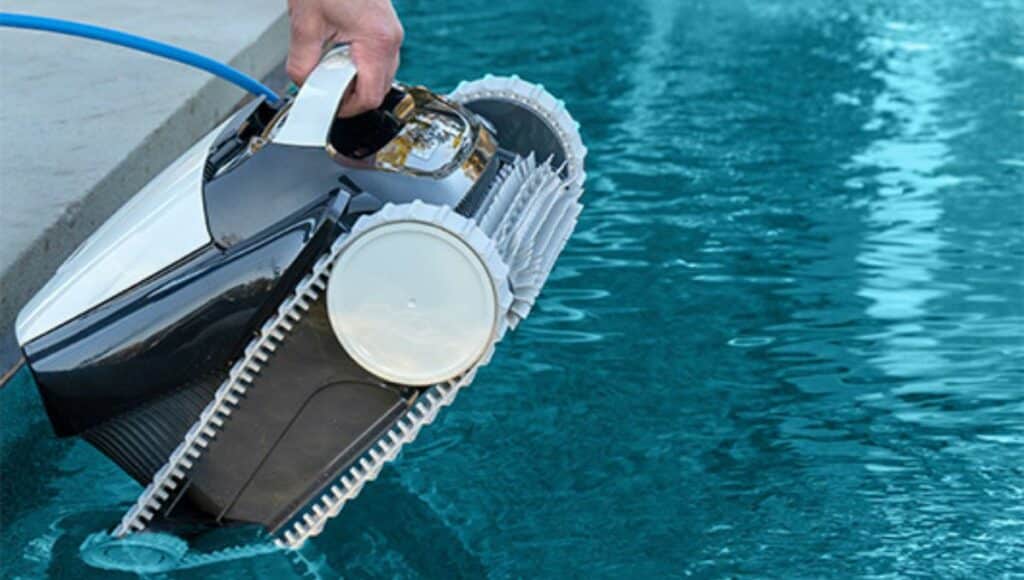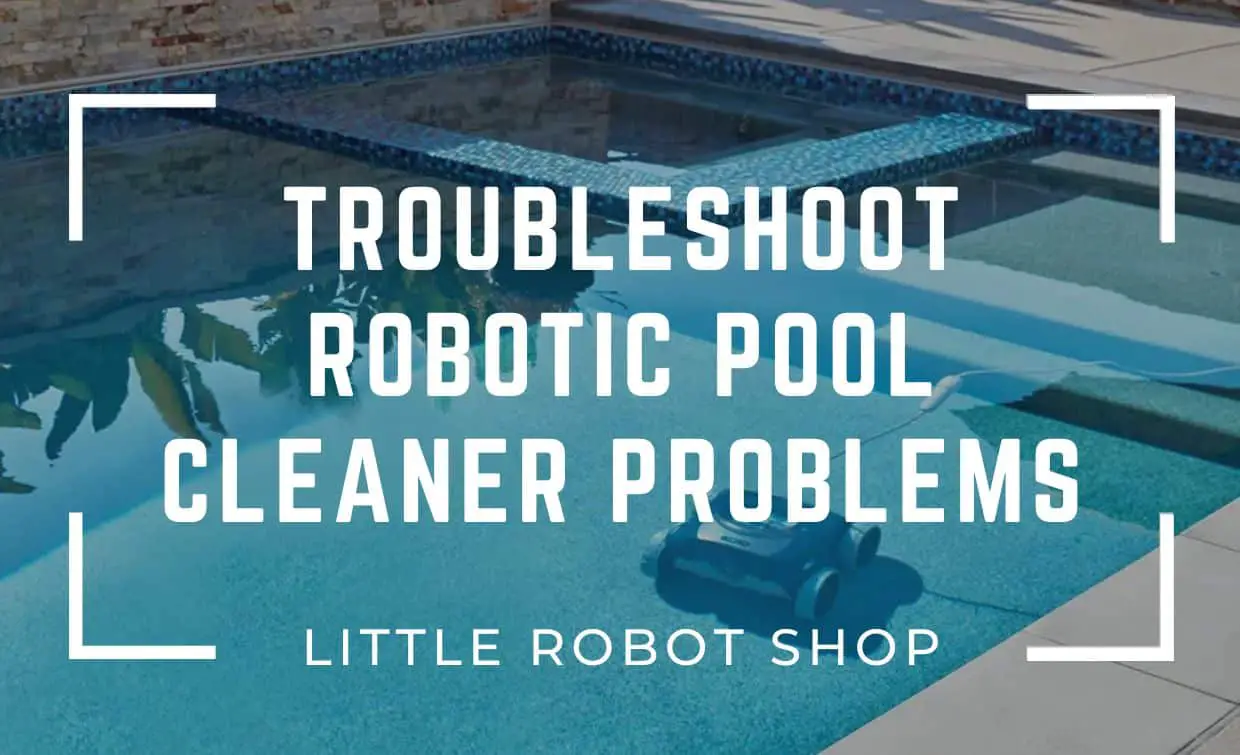When your trusty robotic pool cleaner hits a snag, leisure time can take a nosedive. But don’t worry; you’re about to become your own pool tech superhero! This comprehensive guide will help you know how to troubleshoot common robotic pool cleaner problems and walk you through the troubleshooting process.
We’ve got everything covered, from tangled cables to stubborn dirt spots. But this isn’t just any troubleshooting guide—it’s tailored to be as easy and user-friendly as possible. Dive in and discover how to keep your pool cleaner running like clockwork.
*The product links in this post are affiliate links, which means that if you purchase after following one, I make a small commission from the sale at no additional cost to you. Please see our disclosure page for more information.
You may also enjoy:
- What is a robotic fishing lure, and are they worth buying?
- Can You Leave A Robotic Pool Cleaner In The Pool
Importance of troubleshooting
While robotic pool cleaners are highly effective, they can encounter issues requiring troubleshooting. Knowing how to troubleshoot common problems can help you save time and money on repairs and ensure your pool stays clean and healthy. In the following sections, we’ll explore common robotic pool cleaner problems and how to troubleshoot them.
Common robotic pool cleaner problems
Picture this: It’s a sunny afternoon, and you’ve planned a relaxing day by the pool. You reach for your robotic pool cleaner to ensure everything is spotless, only to find it’s acting up. Frustrating, right? Don’t worry; we’ve got your back. Here’s a handy list of hitches you might encounter with your diligent poolside companion and some initial guidance on how to deal with them:
- The ‘Sleeping’ Robot: Is your automatic pool cleaner refusing to power up? A power supply issue or a defective power cord might be at play.
- The ‘Static’ Robot: Your robotic pool cleaner keeps stopping? Standing still in the middle of the pool? Damaged belts or tracks could be the culprits.
- The ‘Stubborn’ Robot: Is your cleaner playing hide and seek in corners or refusing to climb walls? Hose length, feed hose, or wall fitting connection could pose a challenge.
- The ‘Lazy’ Robot: If your little robot neglects duties by not cleaning the entire swimming pool floor and walls, you might want to inspect the water pressure, cleaner head, or vacuum head.
- The ‘Quick Quit’ Robot: Does your robotic helper seem tired, running for a short period and then taking an early day off? This could be a sign of issues with the pump motor, hose, or filtration system.
Troubleshooting steps
Facing problems with your robotic pool cleaner can be quite a nuisance, right? But hey, don’t stress; most of these snags can be resolved with some detective work. Let’s dive into some common troubleshooting tips to get your device back on track:
- Power Source Troubles: A good starting point is to check if your cleaner is getting the power it needs. Is the indicator light on? If not, verify if your power outlet is functioning and the device’s plug is securely inserted. Also, quickly inspect the power cord for any signs of damage or disconnects.
- Cable and Connections: If the power supply checks out, it’s time to examine the cable and connections. Watch out for any twists, kinks, or damage on the cable. Double-check the connections between the power cord, control box, and cleaner.
- Impeller Inspection: A stationary pool cleaner might hint at a blocked impeller. After safely disconnecting the cleaner, flip it over and thoroughly check the impeller for any debris or blockages.
- Filter Bag Maintenance: Maintaining a clean filter bag is crucial for your cleaner’s top-notch performance. Rinse it thoroughly with a hose, ensuring no debris remains.
- Drive Belts and Tracks: Is your cleaner playing favorites with directions, not completely climbing the pool wall or moving erratically? It’s time to give those drive belts and tracks some attention. Clear off any debris; if they appear worn out, it might be time for replacement tracks or drive motors.
- Water Flow Assessment: If your robotic helper is cleaning less or seems to have slowed down, the water flow could be disrupted. Check on the pool’s filter pump, the cleaner’s feed hose, the suction line, and the cleanliness of your pool’s surfaces.
- Unit Reset: No success yet? A reset might be just what the doctor ordered. As this will vary between models and brands, refer to your owner’s manual to see how to action a factory reset.
- Reach Out to Support: If all else fails, don’t hesitate to contact the manufacturer’s support line. They’re there to help, and who better to assist with stubborn robotic pool cleaner problems? Here are some of the help pages for the most popular brands of automatic pool cleaners:
- Dolphin by Maytronics – click here
- Polaris – click here
- Aiper – click here (details and contact phone and email in the webpage footer)
- Aquabot – click here
By first checking these Robotic Pool Cleaner Troubleshooting Steps, you’re on your way to restoring your device to its top-performing glory. Who knew that tackling common robotic pool cleaner problems could be so straightforward?
Prevention tips
Investing in an automatic pool cleaner certainly pays off, but, like all good things, they need a little TLC to keep them running smoothly. Why wait for problems to arise when you can nip them in the bud? Let’s dive into our pool of knowledge to ensure your little underwater helper stays in pristine condition for years to come.
The fine art of maintaining your robotic pool cleaner
- Fresh Filter Bag, Happy Cleaner: Regularly cleaning your pool cleaner’s filter bag prevents debris buildup, paving the way for a sparkling pool and an extended lifespan for your underwater ally.
- Impeller Inspections: Playing detective with the impeller can uncover hidden debris. A clean impeller equates to an efficient, ready-to-dive cleaner at your service.
- Tracks and Belts: The Heartbeat of Your Cleaner: Keep this crucial machinery clean, and watch your robotic pool cleaner glide through your pool effortlessly, ensuring a longer life of spotless cleaning.
- The Power Cord – A Lifeline Worth Checking: Keeping an eye on the power cord for any wear and tear can save your pool cleaner from unexpected downtime. A healthy power cord equals a relentless cleaner!
Storing your cleaner – Out of pool, Out of harm’s way

- Store in a dry place: After each cleaning round, a dry spot ensures your hardworking cleaner escapes harmful moisture, thus boosting its lifespan.
- Protect from extreme temperatures: An area shielded from harsh weather and away from extreme temperatures is like protective armour for your cleaner, preserving its top-notch functionality.
Proper usage – Mastering the balance for a hardworking pool cleaner
- Respect its Capacity: Overloading your cleaner with debris is just as bad as overeating – it only brings trouble. Keep the intake balanced for optimal performance and a long-lasting cleaning companion.
- The Creator’s Commandments: The manufacturer’s guidelines aren’t just suggestions – they’re your cleaner’s success blueprint. Stick to it and reap the rewards of an efficient, hardworking, and durable device.
- Don’t Overwork Your Cleaner: It’s not a marathon runner! Overuse can lead to early burnout. Stick to the recommended usage frequency and watch your cleaner enjoy a balanced, productive life in your pool.
Frequently asked questions
My robotic pool cleaner won’t turn on. What should I do?
First, make sure the power source is working correctly. Check the outlet and the power cord to see if there are any damages. Then, ensure the cleaner is properly plugged in and the power supply is switched on. If the cleaner still doesn’t turn on, contact the manufacturer or a professional for further assistance.
My robotic pool cleaner doesn’t move. What’s the problem?
Check the drive belts and tracks to see whether they are worn or damaged. Ensure the cleaner is properly plugged in and the power supply is switched on. If these don’t resolve the issue, examine the impeller for blockages or obstructions.
My robotic pool cleaner gets stuck in corners. How can I fix this?
Check the cable and connections to ensure they are not tangled or twisted. Examine the drive belts and tracks for damages that may affect the cleaner’s movement. Also, check the pool’s water flow and adjust it to prevent the cleaner from getting stuck.
My pool cleaner doesn’t clean the entire pool. What should I do?
Check the filter bag for any debris or clogs. Examine the impeller for any blockages affecting the cleaner’s suction power. Additionally, ensure the cleaner runs for the recommended time and properly balances the pool to prevent debris accumulation.
My robotic pool cleaner runs for a short time and shuts off. How can I fix this?
Check the filter bag and impeller for debris or clogs affecting the cleaner’s suction power. Also, examine the cable and connections for any damages that may cause the cleaner to malfunction. If these don’t resolve the issue, contact the manufacturer or a professional for further assistance.
Final thoughts
Pool cleaners are a great way to keep your pool clean and healthy. However, they can encounter problems from time to time. To Troubleshoot common robotic pool cleaner problems can be exhausting and time-consuming, but ensuring the machine works correctly is essential. You can ensure your cleaner works properly by understanding these common problems and following the troubleshooting steps.
Additionally, by following the prevention tips, you can prolong the lifespan of your cleaner and reduce the likelihood of encountering problems. Regular maintenance and troubleshooting are crucial in keeping good pool cleaners working efficiently.
